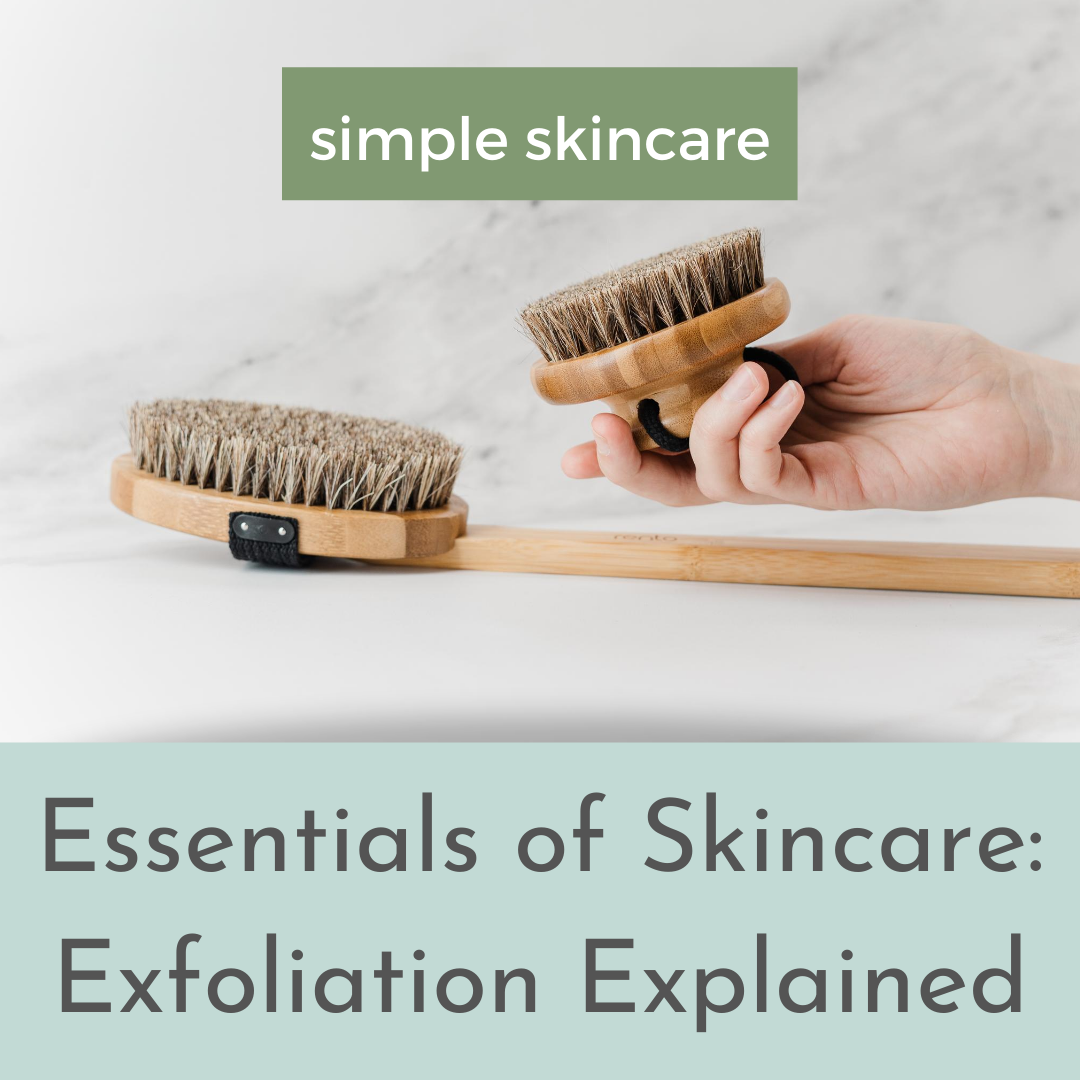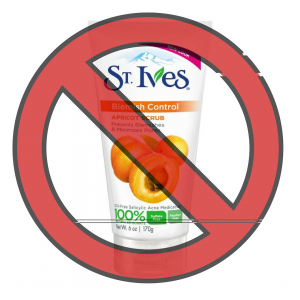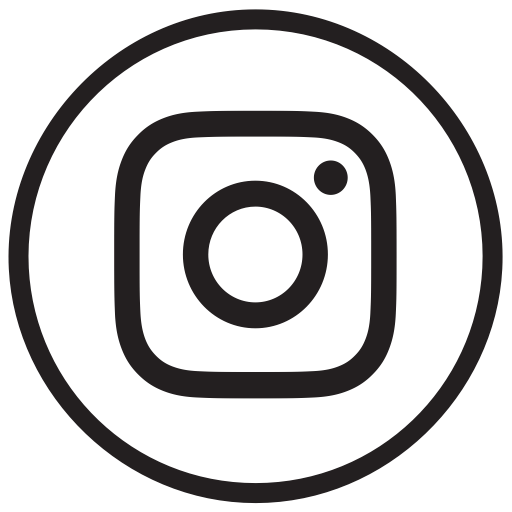
We know that cleansing the skin is the most important building block to achieve healthy youthful glowing skin. Wait, you don’t know that? Well, read all about it here in Essentials of Skincare: Skincare Foundations.
Then we upped our game by adding a serum in Essentials of Skincare: Using a Serum. We also learned some tricks on how to apply products when short on time or have little interest in spending extraneous time in the bathroom.
But maybe you still feel like your skin texture is rough or uneven or you just don’t have the smooth youthful glow you are looking for? What do you do about that?
The Answer is to Exfoliate
Exfoliation is the next essential step of good skincare.
The term “exfoliation” gets tossed around a lot and can be confusing. So first, let’s define it.
Exfoliation is the method of removing the oldest dead skin cells on the skin’s outermost surface. This can be achieved by a mechanical or chemical action. It helps make up for the gradual slowing down of your natural skin renewal process, improving the tone and texture of your skin.

Don’t do it. Please don’t do it!
Does that mean you have to go back to the St. Ives Apricot scrub of your youth? (Oh god, please don’t). What about the plastic microbeads that are destroying our oceans? What if your skin hurts or gets irritated when using a scrub?
Come on now, do you think I would lead you astray?
There are a lot of different ingredients that remove dead skin cells so let’s discuss the different options so you can find one that works for you.
SCRUB
Yes, that old St. Ives product was a scrub. A scrub, sometimes called
- Physical exfoliation
- Manual microdermabrasion
- Polish
This is a product that uses an abrasive ingredient to buff off the top loose dead cells from the surface of your skin. This often provides instant gratification giving the skin a smooth sensation and hopefully a brighter appearance.
However, scrubs can be damaging to the skin, especially if used too often or too aggressively (remember we aren’t trying to scrub our soul clean). Scrubs should not be used on sensitive skins. Also, if your skin has active breakouts, please proceed with caution when using.
Here are my two favorite scrubs:
- Skinscript Raspberry Refining Scrub – the exfoliation is created with cornmeal and jojoba beads so it won’t injure the surface of your skin and it has antioxidants to help fight free radicals that cause cells to break down prematurely. It also feels smooth and has a lovely scent.
- Skinscript 2% Retinol Exfoliating Scrub – the retinol breaks down the glue holding dead skin cells together while the jojoba beads polish them off. This powerhouse scrub also uses kojic acid to lighten pigmentation while brightening the skin overall. For added benefits take a few extra minutes to use this as a mask.
PEEL
The term peel is the most confusing term in our skincare vernacular. It is a catch-all term that is used for EVERYTHING other than a scrub.
Remember the scene in Sex and The City when Samantha got a chemical peel? No?
That was definitely exfoliation but the most extreme version. Her instincts were right but her method was, well, a bit misguided.
Because “peel” covers all the various ways of removing dead skin cells it is an umbrella term for everything from Samantha’s “beef carpaccio” face (which was a medical grade peel – and can’t happen at home) to Sephora’s Mini Peel Pads and everything in between.
So now you ask me… how do you know what is what? Good question! I am just going to go over the most common ingredients one generally finds when shopping solo for skincare.
You have probably heard most of these terms but maybe weren’t 100% sure how they applied to you.
AHA (Alpha-hydroxy Acid) – benefit the skin by breaking down the glue that holds dead skin cells together, thereby removing older cells that have become dry, pigmented, dehydrated or discolored. The most commonly used ingredients are (although this is hardly a complete list):
- Glycolic Acid – sugar cane
- Lactic Acid – sour milk
- Malic Acid – apples
- Citric Acid – citrus fruits
- Tartaric Acid – grape wine
Vitamin A – deeply penetrates the skin by switching on the genes that trigger immature skin cells to become mature epidermal cells. Thereby helping to unclog pores, even out skin discoloration, reduce oiliness, and improve the appearance of fine lines. It is also suggested to help improve collagen production and restore elasticity.
You can find a variety of forms of Vitamin A:
- Retonic Acid
- Retinol (prescription and over the counter)
- Retin-A (prescription)
- Retinal
- Retinyl Palmitate
- Retinaldehyde
- Beta-Carotene
Enzymes – use fruit-based ingredients working similarly to AHAs but a gentler way to shed skin cells and speed up the skin’s natural ability to regenerate healthy cells. Enzymes often provide the skin with a glowing luminescence.
The most popular enzymes used in skincare are:
- Pumpkin
- Bromelain – Pineapple
- Papain – Papaya
- Lemon
Exfoliation products can be packaged a myriad of ways:
- Serum – pump or dropper bottle
- Pre-soaked Pad
- Individual wipe
- Tube
- Jar
- Powder
- Mask
There are also a variety of ways that exfoliation products can be used. My favorite being a sleep-in product. For this type of exfoliation, you would cleanse, apply the product, add a layer of moisturizer if needed. Boom. Go to bed, wake up exfoliated and glowing.
My favorite sleep-in exfoliator is the Skinscript Glycolic and Retinol Pads <link to website>. They are pre-soaked pads that break up surface dead skin cells, release trapped oil while lightening pigmentation. They can be used up to the hairline, down the neck and chest and if there is leftover solution, wipe the excess on the back of your hands.
Most products, however, are the type that you rinse off after the allotted amount of time (usually 8-20 minutes). These days the ingredients are usually formulated to stop working after a given amount of time so there is rarely a chance you could injure yourself with an at-home exfoliating product, but always make sure to follow the directions.
Pro-tip
Pro-Tip: If you don’t feel you have time to for a rinse-off product, wear it in the shower. Apply to clean skin at the sink, get in the shower, do your showering, rinse off before getting out. Easy. It’s ok if it’s a little more or less time then stated in the directions.
A common mistake people make with exfoliating is overdoing it. It’s super important NOT to over exfoliate. This is NOT the instance where more is better – this is truly a “less is ideal” situation. Too much exfoliation can damage the skin, making you sensitive, dry, or flaky, it can even cause breakouts.
So keep to the rule of exfoliating 1-3x a week in the evening, alternating with a hydrating product on your off nights. If you are more sensitive only exfoliate 1-2x a week at night.
The key to youthful glowing skin is kindness. You don’t have to be cruel to get good results. Your skin is there to support you and your inner organs, treat it with love and respect.
Are you confused when to use the exfoliator you have in your arsenal?
Book a complimentary discover call and let’s discuss about your exfoliator!





Leave a Reply